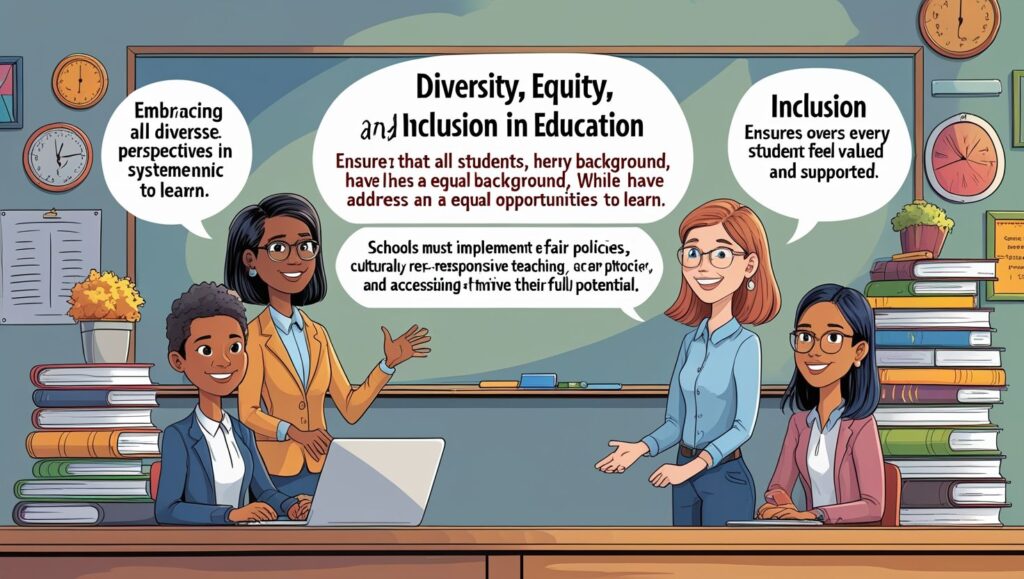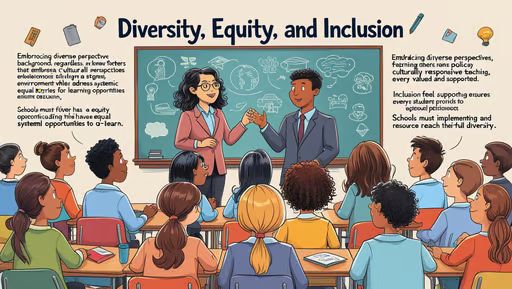Abstract
Diversity, Equity, and Inclusion in Education, Diversity, equity, and inclusion (DEI) are critical pillars of modern education systems, aiming to ensure that all students, regardless of their background, have access to quality education and opportunities for success. However, systemic inequities, cultural biases, and institutional barriers continue to hinder progress toward these goals. This article explores the importance of DEI in education, examines the challenges faced in achieving these principles, and proposes actionable strategies to create more inclusive and equitable learning environments. Drawing on research and case studies, the article argues that a commitment to DEI is essential for fostering social justice, improving educational outcomes, and preparing students for a diverse world.
Introduction
Education is widely regarded as a fundamental human right and a powerful tool for social mobility. However, access to quality education remains uneven, with marginalized groups often facing significant barriers to success. Diversity, equity, and inclusion (DEI) have emerged as central concepts in addressing these disparities, emphasizing the need to create educational environments that respect and value differences, provide equal opportunities, and actively include all students. This article explores the significance of DEI in education, identifies key challenges, and offers recommendations for fostering more inclusive and equitable systems.
1. Understanding Diversity, Equity, and Inclusion in Education
Diversity refers to the presence of differences within a given setting, including race, ethnicity, gender, socioeconomic status, language, religion, disability, and sexual orientation. In education, diversity enriches the learning experience by exposing students to a variety of perspectives and fostering critical thinking and empathy.
Equity involves ensuring that all students have access to the resources and support they need to succeed, recognizing that different students may require different levels of assistance to achieve similar outcomes. Unlike equality, which treats everyone the same, equity addresses systemic barriers and historical disadvantages that disproportionately affect marginalized groups.
Inclusion goes beyond mere representation, focusing on creating environments where all students feel valued, respected, and empowered to participate fully. Inclusive education requires intentional efforts to remove barriers, challenge biases, and promote a sense of belonging.
2. The Importance of DEI in Education
DEI is essential for several reasons. First, it promotes social justice by addressing historical and systemic inequities that have excluded certain groups from educational opportunities. For example, students from low-income families and racial minorities often attend underfunded schools with fewer resources, perpetuating cycles of poverty and inequality (Darling-Hammond, 2010).
Second, DEI enhances educational outcomes. Research shows that diverse and inclusive learning environments improve academic performance, critical thinking, and problem-solving skills (Gurin et al., 2002). When students feel included and supported, they are more likely to engage in learning and achieve their full potential.
Finally, DEI prepares students for a globalized world. As societies become increasingly diverse, the ability to interact with people from different backgrounds is a critical skill. By fostering DEI, education systems can help students develop cultural competence and empathy, which are essential for success in the 21st century.

3. Challenges to Achieving DEI in Education
Despite its importance, achieving DEI in education is fraught with challenges. These include systemic inequities, cultural biases, and institutional resistance to change.
3.1 Systemic Inequities
Systemic inequities are deeply entrenched in many education systems, often reflecting broader societal inequalities. For example, schools in low-income neighborhoods frequently receive less funding than those in wealthier areas, leading to disparities in teacher quality, facilities, and resources (Kozol, 2005). These inequities disproportionately affect students of color, perpetuating racial and socioeconomic achievement gaps.
3.2 Cultural Biases and Stereotypes
Cultural biases and stereotypes can also undermine DEI efforts. Teachers and administrators may hold unconscious biases that affect their expectations and interactions with students. For instance, studies have shown that Black and Latino students are more likely to be disciplined harshly than their White peers for similar behaviors, contributing to the school-to-prison pipeline (Skiba et al., 2011).
3.3 Resistance to Change
Institutional resistance to change is another significant barrier. Efforts to promote DEI are often met with skepticism or opposition, particularly when they challenge existing power structures or require significant resources. For example, initiatives to diversify curricula or implement anti-bias training may face pushback from stakeholders who view them as unnecessary or politically motivated.
4. Strategies for Promoting DEI in Education
To overcome these challenges, education systems must adopt comprehensive and intentional strategies to promote DEI. These strategies should address systemic inequities, challenge cultural biases, and foster inclusive environments.
4.1 Addressing Systemic Inequities
Addressing systemic inequities requires targeted policies and investments to level the playing field. For example, governments can implement funding formulas that allocate more resources to schools serving disadvantaged communities. Additionally, programs such as affirmative action and scholarships can help increase access to higher education for underrepresented groups.
4.2 Challenging Cultural Biases
Challenging cultural biases requires ongoing training and professional development for educators. Anti-bias training can help teachers recognize and address their unconscious biases, while culturally responsive pedagogy can ensure that curricula reflect the experiences and contributions of diverse groups. For example, incorporating literature by authors of color or teaching history from multiple perspectives can help students see themselves represented in the curriculum.
4.3 Fostering Inclusive Environments
Fostering inclusive environments involves creating school cultures where all students feel valued and supported. This can be achieved through initiatives such as peer mentoring programs, student-led diversity clubs, and inclusive policies that protect the rights of marginalized groups. For example, schools can adopt gender-neutral dress codes or provide accommodations for students with disabilities to ensure that everyone can participate fully.
5. Case Studies in DEI in Education
Several case studies illustrate the potential of DEI initiatives to transform education systems. For example, the “Detroit Educational Justice Coalition” has successfully advocated for increased funding and resources for Detroit public schools, which serve a predominantly Black and low-income student population (DEJC, 2020). Similarly, the “Courageous Conversations About Race” framework has been used in schools across the United States to facilitate dialogue about race and racism, helping educators and students address systemic inequities (Singleton, 2014).
Internationally, Finland’s education system is often cited as a model of equity and inclusion. By prioritizing teacher training, reducing standardized testing, and providing comprehensive support for students, Finland has achieved some of the highest educational outcomes in the world, with minimal disparities between schools (Sahlberg, 2015).
6. The Role of Policy and Leadership
Achieving DEI in education requires strong leadership and supportive policies at all levels. Policymakers must prioritize equity in funding, curriculum development, and teacher training, while school leaders must model inclusive practices and create a culture of accountability. For example, school districts can establish DEI committees to monitor progress and ensure that initiatives are aligned with the needs of the community.
7. The Future of DEI in Education
As education systems continue to evolve, the importance of DEI will only grow. Emerging trends such as the increasing use of technology and the growing diversity of student populations present both opportunities and challenges for DEI. For example, while online learning can expand access to education, it can also exacerbate inequities if not designed inclusively. Similarly, as classrooms become more diverse, educators must be prepared to address the unique needs of each student.
Conclusion
Diversity, equity, and inclusion are essential for creating education systems that are fair, effective, and responsive to the needs of all students. While significant challenges remain, the strategies and case studies discussed in this article demonstrate that progress is possible. By addressing systemic inequities, challenging cultural biases, and fostering inclusive environments, educators and policymakers can ensure that every student has the opportunity to succeed. As we look to the future, a commitment to DEI will be critical for building a more just and equitable society.
References
- Darling-Hammond, L. (2010). The Flat World and Education: How America’s Commitment to Equity Will Determine Our Future. Teachers College Press.
- Detroit Educational Justice Coalition (DEJC). (2020). Advocating for Educational Justice in Detroit. Retrieved from https://www.detroitjustice.org
- Gurin, P., Dey, E. L., Hurtado, S., & Gurin, G. (2002). Diversity and Higher Education: Theory and Impact on Educational Outcomes. Harvard Educational Review, 72(3), 330-366.
- Kozol, J. (2005). The Shame of the Nation: The Restoration of Apartheid Schooling in America. Crown Publishing Group.
- Sahlberg, P. (2015). Finnish Lessons 2.0: What Can the World Learn from Educational Change in Finland? Teachers College Press.
- Singleton, G. E. (2014). Courageous Conversations About Race: A Field Guide for Achieving Equity in Schools. Corwin Press.
- Skiba, R. J., Horner, R. H., Chung, C.-G., Rausch, M. K., May, S. L., & Tobin, T. (2011). Race Is Not Neutral: A National Investigation of African American and Latino Disproportionality in School Discipline. School Psychology Review, 40(1), 85-107.

6 thoughts on “Diversity, Equity, and Inclusion in Education”
Comments are closed.